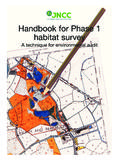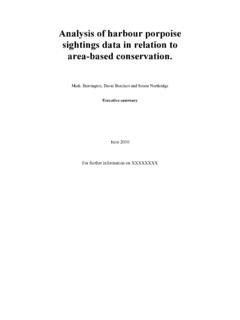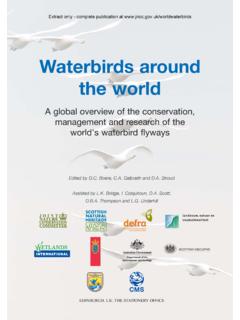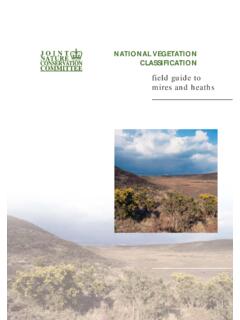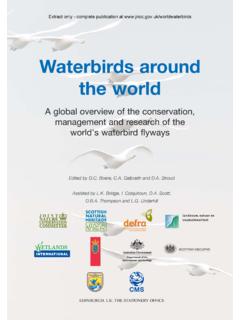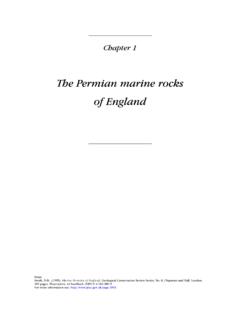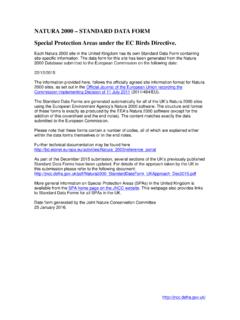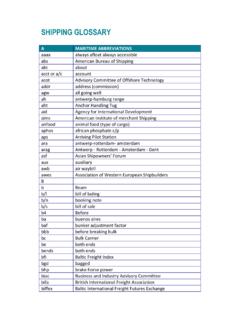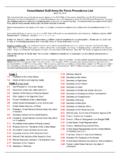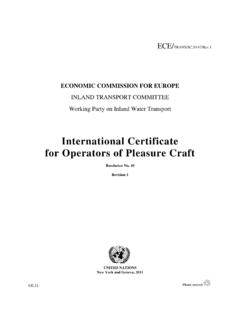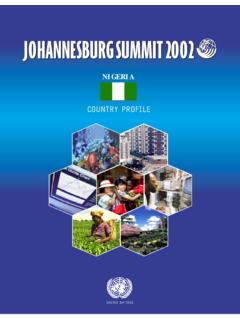Transcription of Guidelines for the Identification and Selection of …
1 1 OSPAR commission Summary Record OSPAR 2003 OSPAR 03/17/1-E, Annex 10 ANNEX 10(Ref. b(i))OSPAR CONVENTION FOR THE PROTECTION OF THE MARINE ENVIRONMENT OF THE NORTH-EAST ATLANTIC MEETING OF THE OSPAR commission (OSPAR) BREMEN: 23 - 27 JUNE 2003 Guidelines for the Identification and Selection of Marine Protected Areas in the OSPAR maritime Area (Reference number: 2003-17) 1. Introduction 1. At Sintra, Portugal, in 1998 the Ministerial Meeting of the OSPAR commission adopted a new Annex V On the Protection and Conservation of the Ecosystems and Biological Diversity of the maritime Area and an accompanying OSPAR Strategy. The objective of the commission is to take the necessary measures to protect and conserve the ecosystems and the biological diversity of the maritime area which are, or could be, affected as a result of human activities, and to restore, where practicable, marine areas which have been adversely affected.
2 2. The commission will, inter alia, promote the establishment of a network of marine protected areas ( MPAs ) to ensure the sustainable use, protection, and conservation of marine biological diversity and ecosystems the OSPAR Network of Marine Protected Areas ( the OSPAR Network ). 3. The establishment of the OSPAR Network will also contribute to and take account of Contracting Parties obligations under other international Conventions and Directives, including EC Directives (and in particular the Council Directive 92/43/EEC on the conservation of natural habitats and wild flora and fauna and the Council Directive 79/409/EEC on the conservation of birds), and measures taken under the Berne, Bonn (including its regional agreements) and Ramsar Conventions, the Convention on Biological Diversity, the Helsinki Convention, the Barcelona Convention, the Trilateral Wadden Sea Co-operation and the commitments made, inter alia, at the World Summit on Sustainable Development and the North Sea Conferences.
3 2. The aim of the OSPAR Network 4. The components of the OSPAR Network will, individually and collectively, aim to: protect, conserve and restore species, habitats and ecological processes which are adversely affected as a result of human activities; prevent degradation of and damage to species, habitats and ecological processes, following the precautionary principle; protect and conserve areas that best represent the range of species, habitats and ecological processes in the OSPAR maritime area. 5. The OSPAR Network should take into account the linkages between marine ecosystems and the dependence of some species and habitats on processes that occur outside the MPA concerned. These relationships are often more complex, and occur on a larger scale, than those of terrestrial ecosystems. 6. The OSPAR Network should form an ecologically coherent network of well-managed MPAs. This is particularly important for highly mobile species, such as certain birds, mammals and fish, to safeguard the critical stages and areas of their life cycle (such as breeding, nursery and feeding areas).
4 2 OSPAR commission Summary Record OSPAR 2003 OSPAR 03/17/1-E, Annex 10 3. The process of Identification and Selection of MPAs Stage 1: Identification of possible sites 7. For this stage, the ecological criteria/considerations listed in Appendix 1 should be applied. 8. In some cases, this stage will identify a number of possible sites, for example to protect a certain species, and it may not be possible to establish them all as MPAs. On the other hand, it may be necessary to select priority sites from a number of possible sites that each meet one or several, but not the same, ecological criteria. For these reasons, sites that meet the ecological criteria/considerations need to be further prioritised at Stage 2. Stage 2: Prioritisation of sites for designation 9. In this second stage of the process, the ecological criteria/considerations listed in Appendix 1 should be reapplied to help prioritise the identified sites.
5 For example, an area that holds a higher population of the species concerned, or that meets additional ecological criteria, may warrant a higher priority. In addition, at this stage, the practical criteria/considerations given in Appendix 2 should be taken into account in developing a prioritised list of sites. For instance an area with a comparatively higher level of support from stakeholders and political acceptability will be more suitable to be established as an MPA. Use of the criteria to meet the aims of the OSPAR Network 10. The table in Appendix 3 provides guidance on which criteria should be used to select areas as components of the OSPAR Network in relation to the identified aims given above. 4. Information on each proposed MPA 11. Information to support the Selection of an MPA within national jurisdiction should be compiled on the proforma given in Appendix 4. The information should be submitted to the OSPAR commission .
6 Any proposals for action by the OSPAR commission in respect of areas outside national jurisdiction should be submitted in the same way. 3 OSPAR commission Summary Record OSPAR 2003 OSPAR 03/17/1-E, Annex 10 Appendix 1 Ecological criteria/considerations An area qualifies for Selection as an MPA if it meets several but not necessarily all of the following criteria. The consideration and assessment of these criteria should be based on best available scientific expertise and knowledge. 1. Threatened or declining species and habitats/biotopes The area is important for species, habitats/biotopes and ecological processes that appear to be under immediate threat or subject to rapid decline as identified by the ongoing OSPAR (Texel-Faial) Selection process. 2. Important species and habitats/biotopes The area is important for other species and habitats/biotopes as identified by the ongoing OSPAR (Texel-Faial) Selection process.
7 3. Ecological significance The area has: a high proportion of a habitat/biotope type or a biogeographic population of a species at any stage in its life cycle; important feeding, breeding, moulting, wintering or resting areas; important nursery, juvenile or spawning areas; or a high natural biological productivity of the species or features being represented. 4. High natural biological diversity The area has a naturally high variety of species (in comparison to similar habitat/biotope features elsewhere) or includes a wide variety of habitats/biotopes (in comparison to similar habitat/biotope complexes elsewhere). 5. Representativity The area contains a number of habitat/biotope types, habitat/biotope complexes, species, ecological processes or other natural characteristics that are representative for the OSPAR maritime area as a whole or for its different biogeographic regions and sub-regions. 6. Sensitivity The area contains a high proportion of very sensitive or sensitive habitats/biotopes or species.
8 7. Naturalness The area has a high degree of naturalness, with species and habitats/biotope types still in a very natural state as a result of the lack of human-induced disturbance or degradation. 4 OSPAR commission Summary Record OSPAR 2003 OSPAR 03/17/1-E, Annex 10 Appendix 2 Practical criteria/considerations 1. Size The size of the area should be suitable for the particular aim of designating the area, including maintaining its integrity, and should enable the effective management of that area. 2. Potential for restoration The area has a high potential to return to a more natural state under appropriate management. 3. Degree of acceptance The establishment of the MPA has a comparatively high potential level of support from stakeholders and political acceptability. 4. Potential for success of management measures There is a high probability that management measures and the ability to implement them (such as legislation, relevant authorities, funding, and scientific knowledge) will meet the aims for designation.
9 5. Potential damage to the area by human activities It is an area where significant damage by human activity may happen in the short term. 6. Scientific value The area has a high value for scientific research and monitoring. 5 OSPAR commission Summary Record OSPAR 2003 OSPAR 03/17/1-E, Annex 10 Appendix 3 Use of the criteria to meet the aims of the OSPAR Network The following table provides a correlation between the ecological and practical criteria/considerations and the aims of the OSPAR Network: Aims of the OSPAR Network Protect, conserve and restore species, habitats and ecological processes which are adversely affected as a result of human activities Prevent degradation of and damage to species, habitats and ecological processes following the precautionary principle Protect and conserve areas which best represent the range of species, habitats and ecological processes in the maritime area Ecological considerations ( ) High priority habitats & species which meet the Texel-Faial criteria of Decline ( ) High priority habitats & species which meet the Texel-Faial criteria of high probability of a significant decline ( ) Important habitats & species which meet the other Faial criteria (global importance, local (species)/regional (habitats) importance, rarity, sensitivity, keystone species, ecological significance) ( ) Sensitivity ( ) Ecological significance ( )
10 High natural biological diversity (of species within a habitat and of habitats in an area) ( ) Representativity, including the biogeographic regions ( ) Naturalness Practical considerations ( ) Size ( ) Potential for restoration( ) Degree of acceptance ( ) Potential for success of management measures ( ) Scientific value ( ) Size ( ) Degree of acceptance ( ) Potential for success of management measures ( ) Scientific value ( ) Potential damage to the area by human activities ( ) Size ( ) Degree of acceptance ( ) Potential for success of management measures ( ) Scientific value Note: Numbers in brackets refer to the specific criteria in the Guidelines for the Identification and Selection of MPAs in the OSPAR maritime area (see Appendices 1 and 2). 6 OSPAR commission Summary Record OSPAR 2003 OSPAR 03/17/1-E, Annex 10 Appendix 4 Proforma for compiling the characteristics of a potential MPA A General information 1.

